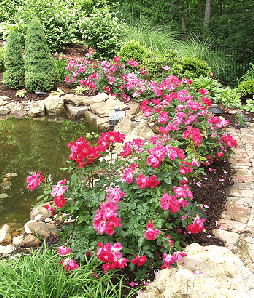how to plant roses
Cold winters have always made it difficult to grow beautiful roses in northern and midwest gardens. There are limited varieties that will survive on their own, many others require winter protection. Many rose bushes require protection even from relatively mild winters (all the way to zone 6 or 7) to ensure a healthy plant in spring that delivers wonderful blooms. Before you introduce roses to your garden be sure you understand the maintenance required. Fortunately, new varieties have recently been bred in Minnesota, Wisconsin and Canada that expand the selection of easy care rose bushes for cold climates.
The basics apply to even modern shrub roses and landscape roses. Growing hybrid tea roses require the most attention in northern climates, many Rugosa roses and hardy shrub roses require little to no special attention. The differences in care requirements are discussed in the details of the individual plants
Planting Rose Bushes
(Also see Transplanting Roses)
Proper planting gives even the hardiest rose bush the best chance of a long and healthy life. Most roses require at least 6 hours of full sun, but all day sun is best especially in cold climates. Good soil and adequate moisture are just as important. To reduce fungus, if possible plant in a site that gets a gentle breeze to increase air circulation. And don’t crowd your plants, give them plenty of their own “air space”.
For bare root roses (no soil, not in a pot) soak the roots in a bucket of water while preparing the planting site. You can soak them up to 12 hours. Then dig a hole wider and deeper than the size of the roots, at least 18” wide and deep, and up to 24”. You can not dig a hole too big, but too small will crowd the roots. And roses do not like wet feet, but they do like lots of moisture. A deep hole will provide good drainage. This is especially important if you have clay or compacted soil that will trap water at the bottom of the hole. If you have sandy or loamy soil, 18” deep should be adequate.
It is wise to test your soil before planting roses. They prefer a neutral soil, or slightly either way acidic or alkaline. If you are planting in acidic or clay soil, add a handful of lime when amending the soil.
Test the hole depth by placing the rose bush in it. Holding the bud union (the “bump” that joins the stem and the root stock) at ground level, the roots should not touch the sides or the bottom of the hole. Sprinkle 1/2 cup of bone meal or superphosphate around the bottom of the hole to stimulate root development. Add compost to the soil you removed, a couple shovels full, and if your soil is clay also add peat moss in the same amount. You may also add extra NATURAL nutrients to the soil, an additional 1/2 cup bone meal and blood meal, and a cup of cottonseed meal. (Chemical fertilizers will burn new roots.) Mix it well, and add a small amount to the hole.
Working the amended soil in with soil from the bottom and sides of the hole, form a mound on the bottom of the hole, continuing to add more amended soil and working in soil from the sides until the mound is large enough to support the plant so the bud union is just above ground level. As the loosened soil settles, the plant will settle lower, leaving the bud union at ground level. Carefully arrange the roots so that the are not tangled or folded. Start adding amended soil, working it in lightly around the roots by hand, until the hole is about 3/4 full, then tamping the soil down lightly. Fill the hole completely with water and let it soak in, then fill again.
Now trim the canes (stems) back to about 6-10 inches and remove any damaged canes. If the canes are twice the size of the roots, there will not be enough root to feed the plant and the rose will grow spindly. Cut just above outside buds on the canes, cutting at an angle with a sharp rose pruner. Finish filling the hole, mounding up the excess right over the canes. This will protect the canes and keep them moist while the rose bush establishes it’s roots. The mound will compress over time with continued watering. If your rose was potted, the same principles apply, but you of course will not form a mound for the roots. Make sure the hole is at least 6 inches wider and deeper than the pot. If the bud union can be seen, position it just above ground level.
Spread a thick layer of mulch around the rose bush to prevent splashing water from spreading any fungus spores that may be present. Water deeply every 4 or 5 days. You do not need to fertilize, the organic amendments you mixed into the soil will feed your rose slowly as it becomes established. A chemical fertilizer can burn new roots. As leaves begin to show in 3 to 6 weeks, spray the stems, leaves, and surrounding soil with a fungicide for black spot. If the soil mound has not completely settled at this point, CAREFULLY remove the mound with your fingers so you don’t damage any new growth.
If you are planting a grafted rose, position the bud union right at soil level, or in colder climates position it 1 or 2 inches or more below the soil level. In zones 4 or colder you may plant the graft union as much as 4 inches deep. If you lose the top growth to winter die-back and the bud onion is protected under the soil, your rose has a chance of re-growing true. Be sure to read the care instructions for grafted roses so you understand the differences between grafted and own-root roses.
